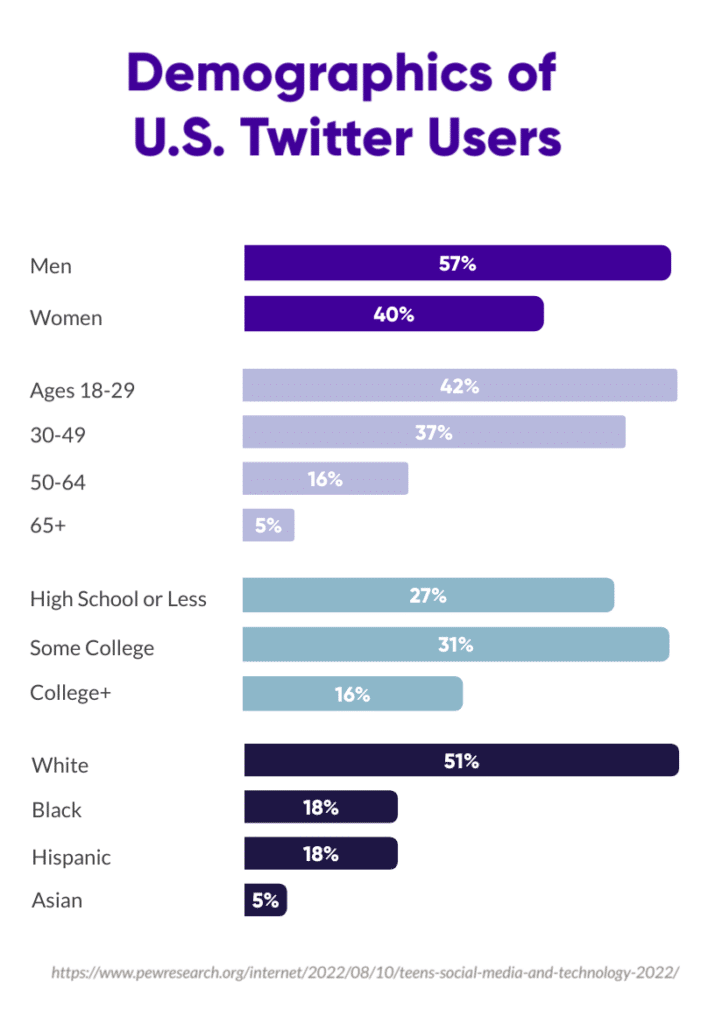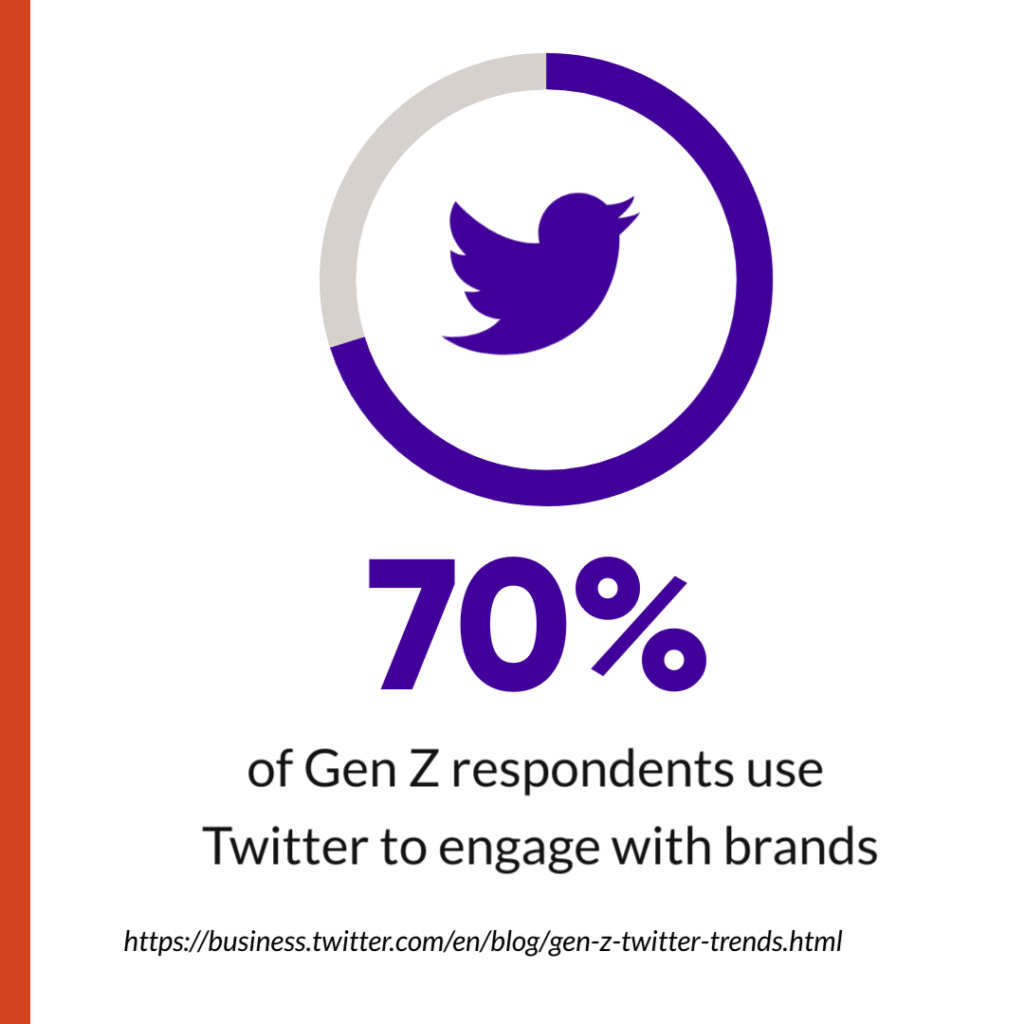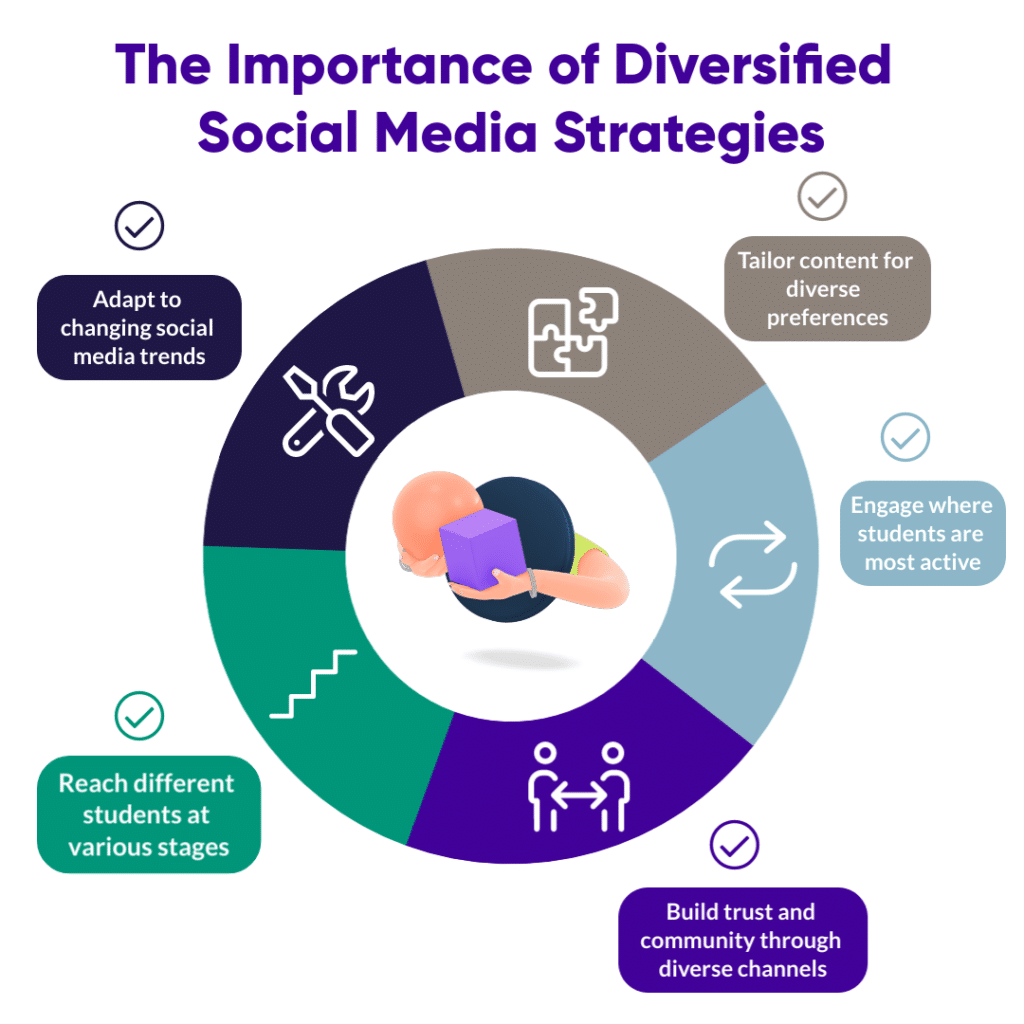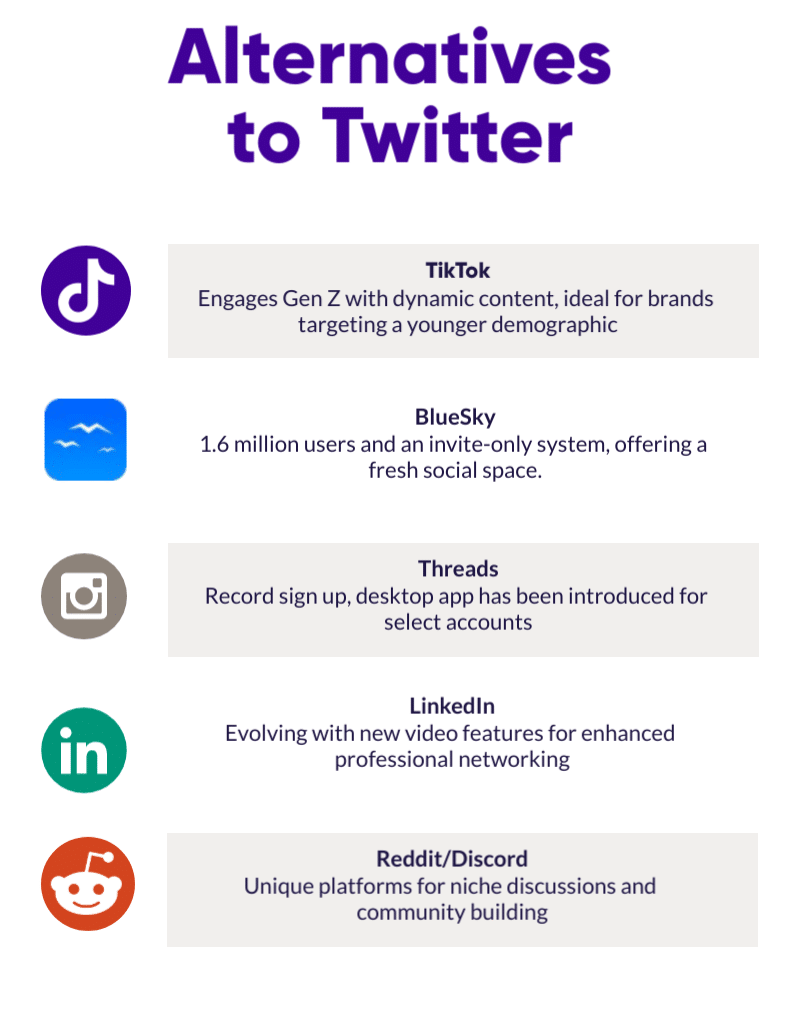Beyond Twitter: Alternative Strategies for Higher Education Social Media Managers

Understanding the Influence of X, formerly known as “Twitter” Updates on Higher Education Social Media Marketing
As a higher education professional, you are working hard to redefine your online presence and find new and exciting ways to connect with students. In your pursuit of this, you have effectively harnessed the power of X, formerly known as “Twitter,” to create a community and share trustworthy information using short-form content.
However, since 2022, you have witnessed a series of shifts in Twitter’s verification process, tweet-viewing limits, and API, among other updates. All of these changes hold considerable significance for you, the higher education social media manager. These changes have transformed how you engage with your audience and necessitate innovative strategies to adapt to Twitter’s evolving landscape.
While respecting the importance of its recent rebranding, it’s worth noting that, for the sake of clarity and recognition, we will use the term ‘Twitter’ throughout this article.
How are the Recent Twitter Changes Affecting Higher Education?
Twitter, under Elon Musk’s leadership, has recently undergone significant changes to its platform in response to evolving user needs and the digital landscape. These updates are driven by a commitment to enhancing your user experience, ensuring authenticity, and giving you more control over your Twitter interactions.
Here are the noteworthy changes that significantly impact you, the higher education social media manager:
Verification Process Updates
Twitter used to give that coveted blue checkmark to accounts that were widely recognized and considered trustworthy. Now, they’ve shifted this to become a paid subscription feature through Twitter Blue. This change emphasizes the importance of authenticity and trustworthiness on the platform.
For you, this signals the significance of credibility. It’s crucial to maintain a reputable online presence, especially when promoting your educational institution. Authenticity and trust are key in attracting prospective students and building a strong online reputation.
Twitter Verified Organizations’ verification process also changed in 2022 following Twitter’s move to make the blue checkmark a Twitter Blue subscriber exclusive. Now, becoming a Verified Organization requires a $1,000/month subscription fee (plus tax), with an extra $50/month (plus tax) for each affiliated account. This shift in the verification process mirrors a broader trend of paid verification services, highlighting the growing importance of trust and authenticity online. For higher education marketers, this emphasizes credibility’s crucial role in attracting students and building a solid online reputation. Just like Twitter, Verified Organizations gain a verified status on X and access to all Twitter Blue features.
Tweet-Viewing Limits
Twitter has introduced daily tweet-viewing limits, varying between verified, unverified, and new unverified accounts. These limits aim to control the amount of information you can consume in a day.
Here are the limits in a nutshell:
- If you’ve got a verified account, you can check out up to 6,000 posts every day
- Unverified accounts get to read 600 posts daily
- And for brand-new unverified accounts, you can scan through 300 posts a day
With limits on how many tweets you can see, it’s essential to craft tweets that grab attention and deliver value in a limited space. This is particularly relevant when promoting courses, events, or updates related to your higher education institution.
Twitter API: Farewell to Free Access
You had wholeheartedly embraced the Twitter API, making it a cornerstone of your digital marketing strategies. It held significant value by granting you invaluable access to a treasure trove of data.
This access included user engagement data, tweet performance metrics, and comprehensive audience demographics. With these insights at your fingertips, you were empowered to assess the effectiveness of your marketing campaigns and tailor your content to align precisely with the preferences and behaviors of your audience.
However, the landscape changed with a transition to a basic paid tier. Twitter developers announced in February 2023 that they are no longer supporting the free tier of the Twitter API. This shift introduces potential constraints.
To accommodate these potential limitations, you will need to adjust your social media strategies. However, if the costs become prohibitive, smaller institutions might fall behind their larger, better-funded counterparts who can still afford these services. The transition to a basic paid tier will require strategic adjustments to fully leverage this resource within the new constraints.
Twitter’s new pricing model limits the number of tweets available within each package, which could restrict the reach of your marketing campaigns. This might lead you to make tough choices about which data to access, potentially causing you to miss out on valuable information.
Current Twitter Trends for Higher Education Marketers
It seems Twitter’s website traffic is taking a hit, with users apparently moving to other platforms like Meta Threads. In July, Twitter started requiring users to log in to view tweets and imposed limits on the number of posts users could read daily to combat scraping efforts. At first, paying users could read 6,000 posts, while non-paying users were limited to 600. These restrictions have been tweaked since, and Twitter recently dropped the login requirement.

Meanwhile, Meta’s new platform, Threads, made a splash by gaining over 70 million users within its first three days of launch, with an expectation of hitting 100 million soon.
The most active Twitter users, the ones who used to tweet the most, have slowed down. On average, they’re posting about 25% less than before Musk’s takeover. Many users have been taking breaks from Twitter. In fact, around 60% of U.S. adults who’ve used Twitter in the past year have recently taken a break from the platform.
Interestingly, even though some are posting less, a big chunk of highly active users have stuck around. About 80% of the most active users from before Musk’s takeover are still among the most active users today. This holds true even when we look at the top 10% of users. Twitter is useful for engaging with students, staying updated on trends, and connecting with thought leaders in higher ed marketing. So, while there have been changes in user behavior, with some posting less and taking breaks, there’s still a core group of highly active users who are continuing to engage with the platform.
You can use Twitter to monitor communication, get feedback, track competitors, and boost engagement with strategic hashtags. In the wider higher ed marketing scene, trends like personalized communication, a student-focused approach, user-generated content, and tracking online leads are becoming more important. The big question is how all of this will affect Twitter’s user base and dynamics in the long term.
Who is still on Twitter?
Under Elon Musk’s leadership, Twitter is still in the top 10 for both Millennials and Gen-Z. Gen Z is now the largest generation on Twitter, and they’re using the platform in new and innovative ways. They’re more about consuming entertainment, which aligns with what Gen Z primarily seeks on social media. They turn to Twitter not just for entertainment but also to stay informed about what’s happening in the world, be it news, pop culture, or internet trends.
When we explore trending topics on Twitter, from movies to gaming to food, it’s Gen Z leading the charge. They initiate trends, keep memes alive, and set the tone for discussions.
For Gen Z, Twitter isn’t just a place to observe; it’s where they engage with brands. A recent survey revealed that 70% of Gen Z respondents use Twitter to discover new product releases. They don’t just passively browse; they are actively vocal about their opinions on the products and services they encounter. Moreover, Gen Z uses Twitter to assess whether brands align with the social and cultural conversations they care about.
Since Gen Z is the biggest group on Twitter, you need to know how vital the platform is for reaching and connecting with this group. Gen Z’s active involvement in discussions and use of Twitter to discover new products indicates an opportunity for you to showcase your institutions, programs, and events on the platform. Their active involvement can significantly extend the reach of your campaign.

Maximizing Engagement with Diverse Social Media Strategies
Social media trends are dynamic, and platforms rise and fall in popularity. Therefore, embracing a diverse approach to social media allows you to adapt to these trends and make strategic decisions that best serve your target audience. By staying flexible and open to change, you ensure that your institution’s social media presence remains both relevant and impactful.

One of the key benefits to diversifying your social media strategy is engaging with prospective and current students at different stages of their journey, providing relevant and valuable information that influences their decision-making process.
For example, a university can leverage platforms like Reddit to create threads where current students share their experiences with specific programs, offering valuable insights into the program’s quality and the student experience. Prospective students can ask questions, seek advice, and gain a more in-depth understanding of what to expect, ultimately influencing their decision to enroll.
Moreover, diversifying your approach lets universities customize their messages and content to match what different groups of people like. For example, future students might prefer platforms like Instagram and TikTok, where they can get a peek into campus life and see what other students have to say. On the other hand, if you’re trying to reach potential grad students or alumni, platforms like LinkedIn can be your best buddies. They’re the places where the academic-minded crowd hangs out.
In essence, a diversified social media strategy empowers universities to meet students where they are, provide the information and support they need, and create a sense of belonging and trust that significantly enhances the student journey.
What Are Suitable Twitter Alternatives for Higher Education Social Media Managers?
Alternatives to Twitter’s short-form content platform are worth exploring. While Twitter provides a distinctive space for engagement, various other social media platforms and marketing tools offer valuable avenues for reaching and connecting with the higher education audience. These alternatives encompass multiple options, each with unique strengths and audience demographics. From BlueSky and Threads to LinkedIn and Reddit, as well as specialized platforms tailored for higher education institutions, marketers have a diverse array of channels to choose from, allowing for a multi-faceted approach to their digital marketing strategies.
Here are some alternatives:
- TikTok: TikTok isn’t just about short videos; it’s a versatile platform. It’s super effective in engaging younger folks, especially Gen Z, who often use TikTok like a search engine to find snappy, informative content. And speaking of the crowd, TikTok mainly draws in younger users, making it a great choice for brands looking to connect with this demographic.
- BlueSky: One of the alternatives to Twitter, Bluesky, has been creating quite a buzz lately. With more than 1.6 million users and a waitlist of over 1.9 million people, it’s gaining popularity. Just like Twitter, it’s feeds-based and operates on an invite-only basis with a waiting list, offering a fresh space for social interaction.
- Instagram Threads: Instagram Threads has been making some notable moves. It’s considering integration with Instagram, which already boasts one of the highest ROIs in the social media realm. Additionally, a desktop app has been introduced for select accounts, enhancing the user experience. Although Threads initially saw a record sign-up, daily active users have witnessed a drop.
- LinkedIn: LinkedIn has been rolling out some exciting new features, with a particular focus on video content. These innovations aim to enhance user engagement and provide a more dynamic platform for professional networking.
- Reddit/Discord: Reddit and Discord are both unique platforms that excel in community building. They offer users a space to connect, share interests, and engage in discussions that may not be as prevalent on other social media sites. The sense of community and niche topics make these platforms stand out in the ever-evolving landscape of online communication.

Diversifying your social media strategies is crucial because your university, just like any other organization, has unique target audiences and specific goals for its social media presence. Prospective students might be more active on platforms like Instagram, TikTok, or even Twitter, while current students might prefer platforms like Discord for in-depth group discussions.
Likewise, the content and approach will vary depending on the goals. Visual platforms like Instagram and YouTube might be essential if your university’s primary goal is to showcase its campus and academic excellence. But if you want to engage with alumni for fundraising, LinkedIn might be more suitable.
Mixing up social media channels allows your university to tailor its approach to its audience’s preferences and engage with them effectively. It’s about reaching the right people on the right platforms with the right message, all aligned with the university’s objectives. A one-size-fits-all strategy rarely works in today’s diverse social media landscape.
Adapting Your Social Media Strategy
It’s crucial to remain adaptable and proactive in your social media strategy. While Twitter should not be abandoned, you should embrace change and expansion, experimenting with diverse platforms to effectively engage your target audience. Researching and experimenting, analyzing your audience, implementing a multichannel strategy, and making data-driven decisions should serve as cornerstones for crafting a relevant and successful social media strategy. This holistic approach ensures that your higher education institution connects with its audience in a meaningful and enduring way.
- Research and Experiment: You should continuously research and experiment with your social media strategy. While you shouldn’t abandon Twitter, you should explore new avenues and expand your offerings to reach your target audience more effectively. This approach allows you to adapt to changing trends and evolving user preferences, ensuring that you remain relevant and engaging across various social media platforms.
- Analyze Your Audience: By thoroughly understanding your audience’s preferences, behaviors, and platform usage, you can tailor your content and approach to engage them better. It’s crucial to evaluate the platforms you’re using. Assess whether they align with your audience’s preferences. If you find that certain groups of students are underrepresented or less engaged on your current platforms, it might be time to explore new ones to reach them effectively.
- Implement a Multichannel Strategy: Different social media platforms cater to diverse preferences and behaviors, so it’s essential to tailor your strategies based on these distinctions. A multichannel strategy broadens your reach and ensures you connect with your audience where they are most comfortable.
- Make Data-Driven Decision: The role of analytics in guiding your social media strategy can’t be overstated. A data-driven approach involves examining metrics such as engagement rates, click-through rates, audience demographics, and post reach. It lets you pinpoint which social media platforms yield the most interaction. A data-driven approach also lets you figure out what kind of content really clicks with your audience and identify the times when they’re most active. Test for a minimum of three months. With this information in hand, you can tailor your strategy to maximize your reach and impact.
By embracing these approaches, you can adapt your social media strategy to engage your target audience effectively, ensuring that your institution remains relevant and influential in the ever-evolving digital landscape.
Alternative Social Media Platforms Can Help You Diversify Your Social Media Strategy
As a social media manager, diversifying your digital presence is a unique opportunity. Explore new platforms aligned with your institution’s goals to thrive in the dynamic world of social media. A well-crafted strategy can completely transform your institution’s engagement.
EducationDynamics offers expert guidance on platform selection, data-driven decision-making, and comprehensive campaign management in the ever-evolving landscape of higher education social media. Partnering with EducationDynamics means strategic content development, insights into paid platforms, and continuous adaptation to trends.
Elevate your institution’s social media presence by reaching out to EDDY for a tailored, industry-leading approach that ensures your strategies remain relevant and drive impactful outcomes.